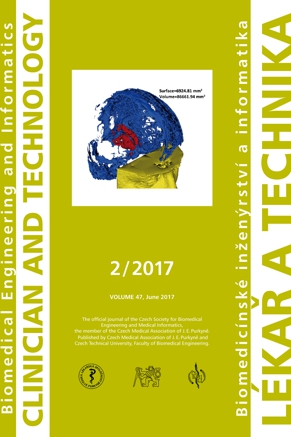RESPIRATORY SOUNDS AS A SOURCE OF INFORMATION IN ASTHMA DIAGNOSIS
Keywords:
asthma, air flow, wheezing, harmonic analysis, Fourier transform, inspiratory phase, expiratory phaseAbstract
Around 300 million people all over the world at all age level suffer from asthma [1]. Patients with this disease have primarily difficult breathing with wheezing in respiratory sounds, cough and feeling of constricted chest. Therefore their physical activity is strongly limited [2]. Nowadays, there are several methods for asthma diagnosis, for example spirometry, measuring of peaks of expiratory velocity or measuring of bronchial reactivity. Although these methods are sufficiently reliable in most cases, they have also some imperfections, which are obvious especially by diagnosing of badly collaborating patients, e.g. small children aged up to three years. These infants can’t provide operations required for diagnosis, so results performed diagnosis are not reliable. For this reason, there is an idea of developing non invasive method of asthma diagnosis and other pulmonary diseases that would not need collaboration of patient [3]. One of the most probably working usable principles is comparison of air flow in airways of healthy and ill person. The difference of the air flow is caused by bronchial obstruction and constriction of airways of patient. There are other sounds and wheezing in the respiratory sounds detectable during breathing as a typical manifestation of the disease [4]. These phenomena can be detected by hearing of sound or by harmonic analysis.Downloads
Published
Issue
Section
License
Copyright (c) 2017 D. Skalicky, F. Lopot, V. Koucky, P. Kubovy, P. Pohunek, V. Zoul, K. Jelen, V. Dynybyl

This work is licensed under a Creative Commons Attribution 4.0 International License.
Authors who publish with this journal agree to the following terms:
- Authors retain copyright and grant the journal right of the first publication with the work simultaneously licensed under a Creative Commons Attribution License (https://creativecommons.org/licenses/by/4.0/) that allows others to share the work with an acknowledgment of the work's authorship and initial publication in CTJ.
- Authors are able to enter into separate, additional contractual arrangements for the non-exclusive distribution of the journal’s published version of the work (e.g., post it to an institutional repository or publish it in a book), with an acknowledgment of its initial publication in this journal.
- Authors are permitted and encouraged to post their work online (e.g., in institutional repositories or on their website or ResearchGate) prior to and during the submission process, as it can lead to productive exchanges.
CTJ requires that all of the content of the manuscript has been created by its respective authors or that permission to use a copyrighted material has been obtained by the authors before submitting the manuscript to CTJ. CTJ requires that authors have not used any copyrighted material illegally, as for example a picture from another journal or book, a photo, etc. It is the author’s responsibility to use only materials not violating the copyright law. When in doubt, CTJ may ask the authors to supply the pertinent permission or agreement about the use of a copyrighted material.
The opinions expressed in CTJ articles are those of authors and do not necessarily reflect the views of the publishers or the Czech Society for Biomedical Engineering and Medical Informatics.


